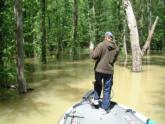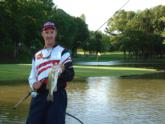Forest fishing

High water on Kentucky, Barkley lakes means FLW Tour anglers will find fish in unlikely places – like trees
Tree tops, birds’ nests, deer stands and even snakes are at eye level this week as FLW Tour anglers fish in the flooded forests of Kentucky and Barkley Lakes on the fifth stop of the Wal-Mart FLW Tour.
Last week heavy rainfall dumped excessive amounts of water into the Tennessee Valley Authority chain of lakes. The bulk of that water is now inundating the last lakes in the system – Kentucky and Barkley.
Over the last few days, Kentucky Lake has risen over 5 feet. Parking lots, campgrounds and golf courses around the lake are partially submerged. At the official FLW Tour launch site at Kentucky Dam Marina, the ramps are under 4 feet of water, and anglers are launching boats right off the parking lot.
With the lake turning into a swollen vein of swift, muddy water, anglers are retreating into Kentucky and Barkley Lakes’ thousands of acres of flooded forests to find fish. Bass have moved into the flooded woods and are occupying places normally reserved for birds and squirrels.
 Anglers have taken to the tedious task of floating into the dense forests to flip and pitch baits into bushes and trees. The process takes a lot of time and a lot of patience. Maneuvering a 20-foot boat around in a flooded forest is difficult. Trees, bushes, vines (including poison ivy) and a maze of floating logs hinder movement considerably.
Anglers have taken to the tedious task of floating into the dense forests to flip and pitch baits into bushes and trees. The process takes a lot of time and a lot of patience. Maneuvering a 20-foot boat around in a flooded forest is difficult. Trees, bushes, vines (including poison ivy) and a maze of floating logs hinder movement considerably.
The process of fishing in the woods is difficult, too. Most anglers are relying on stout pitching and flipping rods spooled with heavy 30-pound-test line to horse fish out of the thick stuff. The fish has the upper hand in this situation as many hook sets result in a lost fish and a hung-up lure. Fish that do make it in the boat often have to be excavated by hand from a snarl of bushes.
Since the bass have so much cover to use, dabbling jigs and heavy plastic baits into tree tops and bushes in an immense flooded forest may seem like a futile effort; however, these two TVA impoundments are loaded with bass.
So far, FLW Tour anglers have enjoyed their practice time because the average catch rate has been about 20 fish per day. But they might get a little frustrated during the tournament since a legal keeper bass must be 15 inches – and keepers have been hard to come by.
 “This lake is slam full of 12- to 14-and-a-half-inch bass,” said FLW Tour pro Andy Morgan of Dayton, Tenn. “I would say the ratio is about 12 nonkeepers for every one keeper.”
“This lake is slam full of 12- to 14-and-a-half-inch bass,” said FLW Tour pro Andy Morgan of Dayton, Tenn. “I would say the ratio is about 12 nonkeepers for every one keeper.”
Morgan is a local favorite on Kentucky Lake when the water is up because of his local knowledge and his penchant for pitching flooded bushes. In fact, Morgan and his fishing teammate, Ramie Colson of Cadiz, Ky., won a local tournament on Saturday with five fish that weighed just over 22 pounds.
Some wonder why Morgan would want to catch such quality fish in a local event when $100,000 is on the line this week.
“If the water keeps rising like this, all those places we caught those fish will be blown out by high, muddy water,” he explained. “You will need a deep-diving crankbait to just hit the tops of the bushes we were flipping on Saturday.”
 From Morgan’s viewpoint, the fast-rising water is causing the lake, and bass, to change drastically every day. “It almost does no good to practice,” he said. “Because what you find today is gone – as in submerged – tomorrow. As long as the water is rising, the fishing is going to be tough. The fish are not really setting up in a predictable way and they are hard to pattern. But, if the water should stabilize, then it could a get a bit better.”
From Morgan’s viewpoint, the fast-rising water is causing the lake, and bass, to change drastically every day. “It almost does no good to practice,” he said. “Because what you find today is gone – as in submerged – tomorrow. As long as the water is rising, the fishing is going to be tough. The fish are not really setting up in a predictable way and they are hard to pattern. But, if the water should stabilize, then it could a get a bit better.”
This week anglers have been far more concerned with water-level forecasts than weather forecasts. In fact, local weather forecasts have not been as important to anglers as rain forecasts farther up the Tennessee River Valley, which would guarantee more water coming into the Kentucky and Barkley systems.
Although the water is not rising as fast as it was over the last few days, it continues to rise and will likely come up at least another foot during the tournament. Morgan, who has never seen the lake any higher than it is now, thinks that having too much water will severely impact the top-10 weight cut. “If it keeps coming up, I think 25 or 26 pounds will be the mark to beat for the top 10,” he said.
The “X” factor in this event could be the smallmouth. “There are a lot of good smallmouth in this lake, and I honestly don’t know how all of this water is going to affect those brown fish,” Morgan noted. “Some guys might surprise us with 13- to 15-pound bags of smallmouth.”
If there is a solid smallmouth bite going on, anglers have done well in keeping it under their fishing caps. Chances are most of the fishing in this event will be done in the flooded forests.